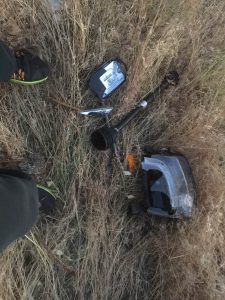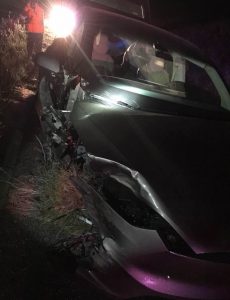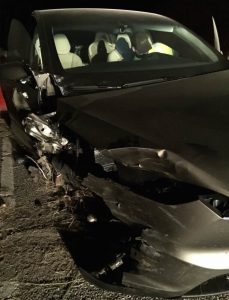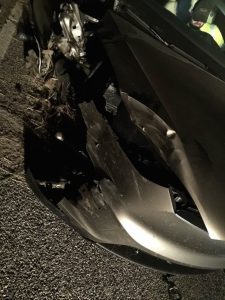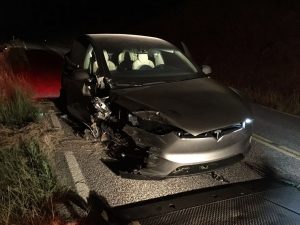News
Driver of Model X crash in Montana pens open letter to Musk, calls Tesla drivers “lab rats” [Updated]
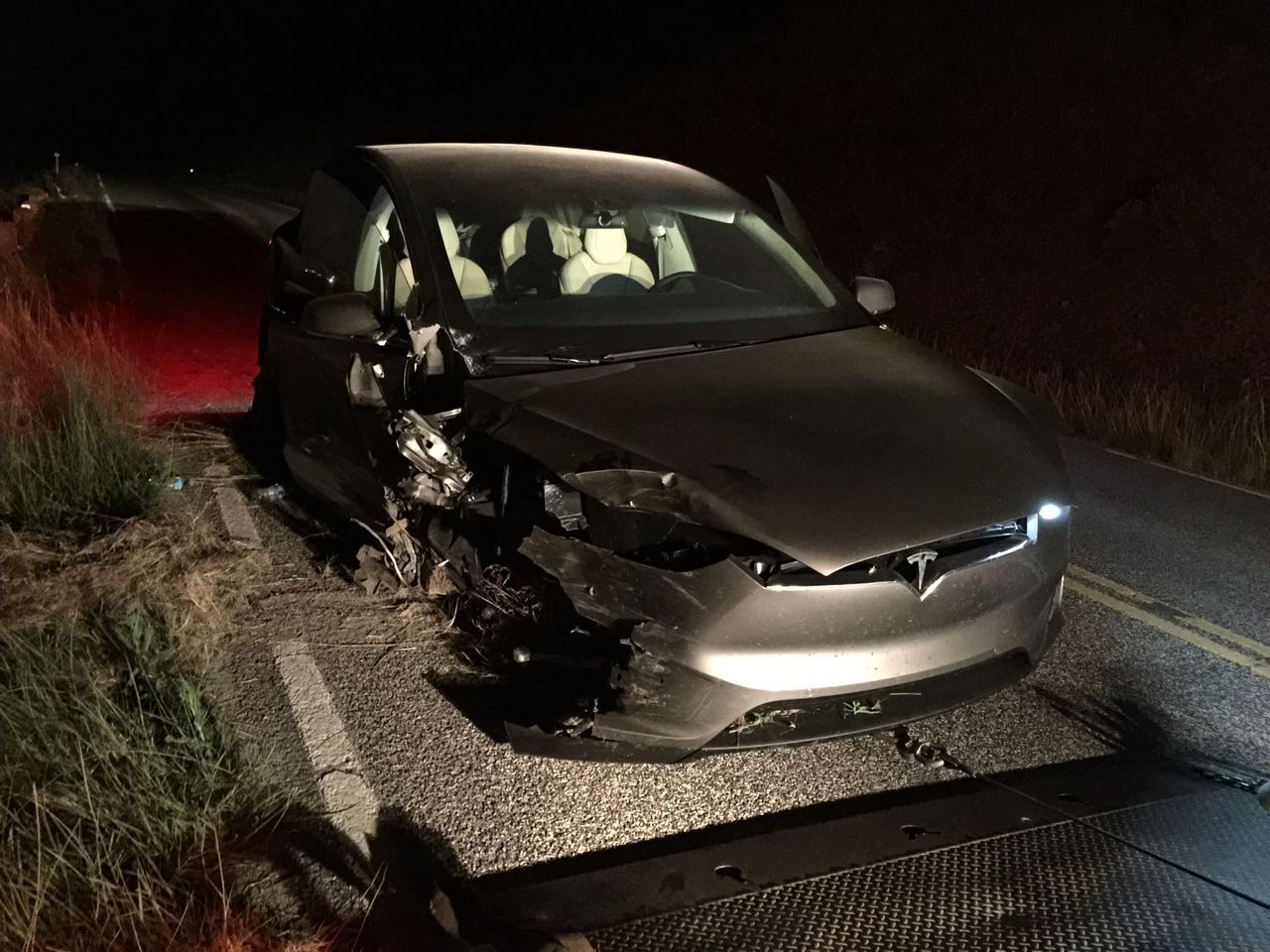
Pang, the driver of the Model X that crashed in Montana earlier this month has posted an open letter to Elon Musk and Tesla asking the company to “take responsibility for the mistakes of Tesla products”. He accuses Tesla for allegedly using drivers as “lab rats” for testing of its Autopilot system.
In an email sent to us and also uploaded to the Tesla Motors Club forum, Pang provides a detailed account of what happened the day of the crash. He says he and a friend drove about 600 miles on Interstate 90 on the way to Yellowstone National Park. When he exited the highway to get on Montana route 2, he drove for about a mile, saw conditions were clear, and turned on Autopilot again. Pang describes what happened next as follows:
“After we drove about another mile on state route 2, the car suddenly veered right and crashed into the safety barrier post. It happened so fast, and we did not hear any warning beep. Autopilot did not slow down at all after the crash, but kept going in the original speed setting and continued to crash into more barrier posts in high speed. I managed to step on the break, turn the car left and stopped the car after it crashed 12 barrier posts.
“After we stopped, we heard the car making abnormal loud sound. Afraid that the battery was broken or short circuited, we got out and ran away as fast as we could. After we ran about 50 feet, we found the sound was the engine were still running in high speed. I returned to the car and put it in parking, that is when the loud sound disappeared.”
Pang goes on to explain how his Tesla Model X driving on Autopilot continued to travel on its own even after veering off the road and crashing into a roadside stake. “I was horrified by the fact that the Tesla autopilot did not slow down the car at all after the intial crash. After we crashed on the first barrier post, autopilot continued to drive the car with the speed of 55 to 60 mph, and crashed another 11 posts. Even after I stopped the car, it was still trying to accelerate and spinning the engine in high speed. What if it is not barrier posts on the right side, but a crowd?”
Photo credit: Steven Xu
After the accident, Tesla reviewed the driving logs from the Model X and reported that the car was operating for more than two miles with no hands on the steering wheel, despite numerous alarms and warnings issued by the car. Pang says he never heard any audible warnings. Comments on TMC range from the incredulous to the acerbic. Most feel Teslas simply don’t operate the way Pang said his car did. Among other discrepancies, the cars are designed to put themselves in Park if the driver’s door is opened with no one in the driver’s seat.
But that hasn’t stopped Pang from voicing his strong opinions on Tesla’s Autopilot system. “It is clear that Tesla is selling a beta product with bugs to consumers, and ask the consumers to be responsible for the liability of the bugging autopilot system. Tesla is using all Tesla drivers as lab rats.”
A car that crashes but continues to accelerate is certainly a scary thought. There is no way to resolve the discrepancy between what Pang says happened and Tesla’s account of what occurred. In an updated email sent to us by friend and english translator for Mandarin speaking Pang, Tesla has reached out to Pang to address the matter.
The original open letter from Pang reads as follows:
A Public Letter to Mr. Musk and Tesla For The Sake Of All Tesla Driver’s Safety
From the survivor of the Montana Tesla autopilot crash
My name is Pang. On July 8, 2016, I drove my Tesla Model X from Seattle heading to Yellowstone Nation Park, with a friend, Mr. Huang, in the passenger seat. When we were on highway I90, I turned on autopilot, and drove for about 600 miles. I switched autopilot off while we exited I90 in Montana to state route 2. After about 1 mile, we saw that road condition was good, and turned on autopilot again. The speed setting was between 55 and 60 mph. After we drove about another mile on state route 2, the car suddenly veered right and crashed into the safety barrier post. It happened so fast, and we did not hear any warning beep. Autopilot did not slow down at all after the crash, but kept going in the original speed setting and continued to crash into more barrier posts in high speed. I managed to step on the break, turn the car left and stopped the car after it crashed 12 barrier posts. After we stopped, we heard the car making abnormal loud sound. Afraid that the battery was broken or short circuited, we got out and ran away as fast as we could. After we ran about 50 feet, we found the sound was the engine were still running in high speed. I returned to the car and put it in parking, that is when the loud sound disappeared. Our cellphone did not have coverage, and asked a lady passing by to call 911 on her cellphone. After the police arrived, we found the right side of the car was totally damaged. The right front wheel, suspension, and head light flied off far, and the right rear wheel was crashed out of shape. We noticed that the barrier posts is about 2 feet from the white line. The other side of the barrier is a 50 feet drop, with a railroad at the bottom, and a river next. If the car rolled down the steep slope, it would be really bad.
Concerning this crash accident, we want to make several things clear:
1. We know that while Tesla autopilot is on but the driver’s hand is not on the steering wheel, the system will issue warning beep sound after a while. If the driver’s hands continue to be off the steering wheel, autopilot will slow down, until the driver takes over both the steering wheel and gas pedal. But we did not hear any warning beep before the crash, and the car did not slow down either. It just veered right in a sudden and crashed into the barrier posts. Apparently the autopilot system malfunctioned and caused the crash. The car was running between 55 and 60 mph, and the barrier posts are just 3 or 4 feet away. It happened in less than 1/10 of a second from the drift to crash. A normal driver is impossible to avoid that in such a short time.
2. I was horrified by the fact that the Tesla autopilot did not slow down the car at all after the intial crash. After we crashed on the first barrier post, autopilot continued to drive the car with the speed of 55 to 60 mph, and crashed another 11 posts. Even after I stopped the car, it was still trying to accelerate and spinning the engine in high speed. What if it is not barrier posts on the right side, but a crowd?
3. Tesla never contacted me after the accident. Tesla just issued conclusion without thorough investigation, but blaming me for the crash. Tesla were trying to cover up the lack of dependability of the autopilot system, but blaming everything on my hands not on the steering wheel. Tesla were not interested in why the car veered right suddenly, nor why the car did not slow down during the crash. It is clear that Tesla is selling a beta product with bugs to consumers, and ask the consumers to be responsible for the liability of the bugging autopilot system. Tesla is using all Tesla drivers as lab rats. We are willing to talk to Tesla concerning the accident anytime, anywhere, in front of the public.
4. CNN’s article later about the accident was quoting out of context of our interview. I did not say that I do not know either Tesla or me should be responsible for the accident. I might consider buying another Tesla only if they can iron out the instability problems of their system.
As a survivor of such a bad accident, a past fan of the Tesla technology, I now realized that life is the most precious fortune in this world. Any advance in technology should be based on the prerequisite of protecting life to the maximum extend. In front of life and death, any technology has no right to ignore life, any pursue and dream on technology should first show the respect to life. For the sake of the safety of all Tesla drivers and passengers, and all other people sharing the road, Mr. Musk should stand up as a man, face up the challenge to thoroughly investigate the cause of the accident, and take responsibility for the mistakes of Tesla product. We are willing to publicly talk to you face to face anytime to give you all the details of what happened. Mr. Musk, you should immediately stop trying to cover up the problems of the Tesla autopilot system and blame the consumers.
Tesla’s Response on TMC
TM Ownership, Saturday at 12:11 PM
Dear Mr. Pang,
We were sorry to hear about your accident, but we were very pleased to learn both you and your friend were ok when we spoke through your translator on the morning of the crash (July 9). On Monday immediately following the crash (July 11), we found a member of the Tesla team fluent in Mandarin and called to follow up. When we were able to make contact with your wife the following day, we expressed our concern and gathered more information regarding the incident. We have since made multiple attempts (one Wednesday, one Thursday, and one Friday) to reach you to discuss the incident, review detailed logs, and address any further concerns and have not received a call back.
As is our standard procedure with all incidents experienced in our vehicles, we have conducted a thorough investigation of the diagnostic log data transmitted by the vehicle. Given your stated preference to air your concerns in a public forum, we are happy to provide a brief analysis here and welcome a return call from you. From this data, we learned that after you engaged Autosteer, your hands were not detected on the steering wheel for over two minutes. This is contrary to the terms of use when first enabling the feature and the visual alert presented you every time Autosteer is activated. As road conditions became increasingly uncertain, the vehicle again alerted you to put your hands on the wheel. No steering torque was then detected until Autosteer was disabled with an abrupt steering action. Immediately following detection of the first impact, adaptive cruise control was also disabled, the vehicle began to slow, and you applied the brake pedal.
Following the crash, and once the vehicle had come to rest, the passenger door was opened but the driver door remained closed and the key remained in the vehicle. Since the vehicle had been left in Drive with Creep Mode enabled, the motor continued to rotate. The diagnostic data shows that the driver door was later opened from the outside and the vehicle was shifted to park. We understand that at night following a collision the rotating motors may have been disconcerting, even though they were only powered by minimal levels of creep torque. We always seek to learn from customer concerns, and we are looking into this behavior to see if it can be improved. We are also continually studying means of better encouraging drivers to adhere to the terms of use for our driver assistance features.
We are still seeking to speak with you. Please contact Tesla service so that we can answer any further questions you may have.
Sincerely,
The Tesla team
Elon Musk
Elon Musk confirms Grok 4 launch on July 9 with livestream event
The rollout will be accompanied by a livestream at 8 p.m. Pacific Time.

Elon Musk has officially confirmed that Grok 4, the latest version of xAI’s large language model, will launch on July 9. The rollout will be accompanied by a livestream at 8 p.m. Pacific Time, hosted on xAI’s official account on X.
xAI goes straight to Grok 4
Back in May, leaks indicated that xAI was getting ready to ship Grok 3.5. Considering Musk’s recent comments, however, it appears that the artificial intelligence startup would be focusing on the large language model’s fourth iteration instead. As noted in a Financial Express report, users on X have sighted references to Grok 4 in the lead up to the update’s launch, such as “grok-4-prod-mimic” and “Grok 4 Code.”
Musk’s Grok 4 announcement comes as AI competition intensifies between major players including OpenAI, Google, and xAI. With Musk’s Colossus supercomputer fully operational in Memphis, xAI appears to be accelerating its AI product roadmap.
Musk pushes Grok toward political neutrality
Grok 4’s launch also follows a recent controversy involving political bias, as noted in a CNN report. Last week, Grok responded to a user on X stating that political violence in the U.S. since 2016 had come more from the political right than the left. The chatbot noted in a later reply that its answer was based on information from sources like Reuters, the Journal of Democracy, and University of Maryland studies.
Musk stated that Grok’s response was a “major fail.” “Major fail, as this is objectively false. Grok is parroting legacy media. Working on it,” he wrote in a post on X. By the end of June, Musk noted that he was “grinding all night with the xAI team” and that they were making “good progress.” He also stated that the model “Will be called Grok 4. Release just after July 4th. Needs one more big run for a specialized coding model.”
News
Tesla opens massive solar Supercharger station in California
The Supercharger opened to customers ahead of Fourth of July weekend, while Tesla continues phase two of construction on the site.

Tesla has officially launched the first several Supercharging posts at a massive station in California, notably including solar canopies and grid-scale batteries to offer completely renewable charging.
Last week, Tesla announced on X that it opened the first 84 Supercharger stalls of a planned 168-stall station in Lost Hills, California. Additionally, the massive Supercharger project features 11MW of solar canopies and 10 Megapack batteries for off-grid charging powered entirely by solar energy.
Tesla completed the first phase of the project just days ahead of the busy Fourth of July holiday weekend, adding that initial construction took just eight months. In addition to the remaining charging stalls, Tesla says it’s building a set of lounge areas, renderings of which can be seen below alongside current photos of the site.
Notably, the site also includes V4 charging posts for the company’s latest available charging speeds, and it’s located near the busy junction between I-5 and Highway 46 in Kern County.
“Thank you [Kern County] and [PG&E] for collaboration and approvals,” Tesla wrote in a follow-up post.

Credit: Tesla Charging | X

Credit: Tesla Charging | X

Credit: Tesla Charging | X

Credit: Tesla Charging | X
Tesla Supercharger Maps for North America, Europe, and Asia pic.twitter.com/0U5r0XRPyo
— TESLARATI (@Teslarati) July 2, 2025
READ MORE ON TESLA SUPERCHARGERS: Tesla launches ultra-fast V4 Superchargers in China for the first time
Testing at the LA Diner, plus Musk update on potential Tesla solar Gigafactory
The huge Tesla Supercharger station completed phase one of construction fairly quickly, especially given how long Tesla has been working on its unique Los Angeles diner, drive-in, and Supercharger location. Still, the company was seen performing some testing at the nearly-completed charging station earlier this month, and will reportedly be holding a job fair.
Elon Musk also responded on Monday morning to a post on X, suggesting that Tesla is “thinking about” building a U.S.-based solar Gigafactory in order to help support increased power needs with AI growth, and to bolster domestic solar production.
Tesla is building a new UFO-inspired Supercharger in the heart of Alien country
News
Tesla driver walks away from major accident with minor injuries
The driver sustained only minor injuries, and the exact cause of the crash remains under investigation.

The driver of a Tesla Model Y survived and walked away from a harrowing accident on Monday in California, only sustaining minor injuries despite the vehicle being impaled by a guardrail.
On Monday morning around 4:34 a.m., the Los Banos division of the California Highway Patrol (CHP) responded to the accident on I-5 near Panoche Road, involving a 23-year-old in a Tesla Model Y. According to a post on social media, the driver veered off the road for unknown reasons in the northbound lane, before crashing directly into the guardrail and impaling the vehicle.
You can read the full message and photos from Los Banos CHP below, as were shared in a Facebook post on Monday afternoon.
This morning a Tesla model y was traveling in the #1 northbound lane of I-5 north of Panoche Rd. For unknown reasons driver allowed V-1 to veer off the roadway, travel through a dirt center divide, and crashed into the fixed metal guardrail. Lucky for the driver he only sustained minor injuries and was able to walk away. Driving a vehicle requires 100% attention to the road. Avoid distractions and focus on driving.

Credit: CHP Los Banos (via Facebook)

Credit: CHP Los Banos (via Facebook)

Credit: CHP Los Banos (via Facebook)
In a statement to SFGate, CHP officer Myles Anderson said that the driver only sustained minor injuries, while no arrests are made and drugs and alcohol are not suspected to have been involved. The report also notes that Tesla’s “cruise control and lane assistance features” were activated, according to Anderson. However, it’s not entirely clear if this is referring to Supervised Full Self-Driving (FSD), or to the cruise control and lane assist features baked into Autopilot.
At the time of writing, CHP has not yet responded to Teslarati’s request for clarification and additional details on the matter.
Tesla Crash Safety Ratings across its lineup: pic.twitter.com/ny30R7ceji
— TESLARATI (@Teslarati) July 1, 2025
READ MORE ON TESLA SAFETY: Tesla rolls out crucial new safety feature aimed at saving children
The news comes after Tesla has touted its vehicles as incredibly safe for many years. In December, for example, the company highlighted receiving top safety scores from regulators on four different continents throughout the world, including from the National Highway Traffic Safety Administration (NHTSA) and the Insurance Institute of Highway Safety (IIHS) in the U.S.
Tesla has also listed the goal of making its vehicles the safest on the road throughout the years, both in the overall design of its vehicles and in its Autopilot and Full Self-Driving (FSD) programs.
Tesla Model 3 ranks as the safest new car in Europe for 2025, per Euro NCAP tests
-

 Elon Musk1 week ago
Elon Musk1 week agoTesla investors will be shocked by Jim Cramer’s latest assessment
-

 News2 weeks ago
News2 weeks agoTesla Robotaxi’s biggest challenge seems to be this one thing
-

 News2 weeks ago
News2 weeks agoWatch the first true Tesla Robotaxi intervention by safety monitor
-

 Elon Musk1 week ago
Elon Musk1 week agoA Tesla just delivered itself to a customer autonomously, Elon Musk confirms
-

 News2 weeks ago
News2 weeks agoTesla Robotaxi rollout proves that Elon Musk still delivers, even if it’s late
-

 Elon Musk2 weeks ago
Elon Musk2 weeks agoxAI welcomes Memphis pollution results, environmental groups push back
-

 Elon Musk2 weeks ago
Elon Musk2 weeks agoElon Musk commends Tesla team on successful Robotaxi launch
-

 Elon Musk2 weeks ago
Elon Musk2 weeks agoElon Musk confirms Tesla Optimus V3 already uses Grok voice AI

